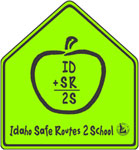
|
CONNECTIONS
|
IDAHO
ITD
HOME
IDAHO DMV
ITD
NEWS
HIGHWAY
SAFETY
IDAHO STATE
POLICE
TRAVEL SERVICES
STATE OF IDAHO
NATIONAL
AASHTO
AAMVA
AAA of IDAHO
FEDERAL HIGHWAYS
FEDERAL AVIATION
IDAHO STATE POLICE
NHTSA
NTSB
TRB
U.S. DOT
Idaho
Transportation
Department
Public Affairs Office
P.O. Box 7129
Boise, ID 83707
208.334.8005
Fax: 208.334.8563
Email

Safe Routes to Schools program provides
first round of reimbursement funds
Lena Whitmore Elementary School in Moscow is surrounded by a subdivision built in the 1960s when construction of sidewalks was an afterthought. Many children face difficult challenges just to travel safely from home to school and back everyday.
Children walking from Hailey Elementary School face similar trials when traveling on a four-block, multi-use path along Elm Street.
Moscow is responding by adding sidewalks to connect the school to existing paths and providing a contiguous eight-block route for children to walk or bicycle to school. Projects also include development of maps, participation in International Walk to School Day, a children's safety fair and bike rodeos, walking/biking “trains” and walking/bicycle safety presentations by the University of Idaho and Moscow police.
 Travel
is being made safer for children in Hailey by construction of four blocks
of sidewalks that connect with improvements the school district is making
this year. The school is producing educational materials for parents,
conducting workshops and public meetings, developing route maps, collaborating
with police for bike and pedestrian safety workshops and posting information
on the Wood River Rideshare Web site.
Travel
is being made safer for children in Hailey by construction of four blocks
of sidewalks that connect with improvements the school district is making
this year. The school is producing educational materials for parents,
conducting workshops and public meetings, developing route maps, collaborating
with police for bike and pedestrian safety workshops and posting information
on the Wood River Rideshare Web site.
Projects in both communities will receive reimbursements from a federal transportation program administered by the Idaho Transportation Department. Safe Routes to Schools was created as part of the federal transportation bill - Safe, Affordable, Flexible, Efficient Transportation Equity Act – a Legacy for Users.
Josephine O’Connor assumed leadership of the program created last year under the auspices of the Office of Highway Operations and Safety. She organized the Safe Routes to Schools office, established a statewide advisory committee and helped create application criteria for project reimbursement.
 Bowen
Huntsman, who co-chairs the advisory committee with Molly O'Reilly of
Sandpoint, presented an overview of the program to the transportation
board last week. He also requested reimbursements of more than $1.5
million for infrastructure and non-infrastructure projects in every
district of the state.
Bowen
Huntsman, who co-chairs the advisory committee with Molly O'Reilly of
Sandpoint, presented an overview of the program to the transportation
board last week. He also requested reimbursements of more than $1.5
million for infrastructure and non-infrastructure projects in every
district of the state.
Forty-six elementary and middle schools participated in the first year of the program that emphasizes safe travel – primarily by bicycle and walking. The benefits are far-reaching Huntsman told the board. Forsaking rides in passenger vehicles or buses encourages physical activity and healthy interaction among students and adult companions, eases congestion near schools, reduces air pollution and conserves natural resources.
State or local governments, schools, school districts, and non-profit organizations are eligible to apply for Safe Routes to School reimbursements. Projects are limited to elementary through middle or junior high (grades K-8) that are within two miles of the school. Funded projects provide full reimbursements for completed projects that comply with Federal Highway Administration requirements.
In Idaho, funding is limited to $100,000 for infrastructure projects and $25,000 for non-infrastructure projects. Improvements that qualify as infrastructure include sidewalks, striping, signs, flashing school zone lights and solar speed limit signs. Non-infrastructure projects include walking school buses, bicycle rodeos, incentives, creation of Safe Routes to Schools committees and crossing guard supplies.
The transportation board approved the following projects for 2006-07 reimbursements:
| Ada County Highway District | $78,419 |
| City of American Falls | $68,645 |
| City of Ammon | $87,620 |
| City of Bellevue | $94,494 |
| City of Dayton | $42,250 |
| City of Driggs | $89,443 |
| City of Coeur d’Alene | $101,600 |
| City of Grace | $7,292 |
| City of Hailey | $90,595 |
| City of Ketchum | $104,360 |
| City of Lewiston | $102,320 |
| City of Moscow | $113,750 |
| City of New Plymouth | $87,000 |
| City of Rockland | $76,000 |
| City of Salmon | $103,832 |
| City of Sandpoint | $97,030 |
| City of Troy | $80,755 |
| Boise School District/YMCA | $25,000 |
| Bonneville School District | $5,000 |
| Wood River Rideshare | $21,900 |
| Statewide Services | $50,000 |
Published 5-25-07